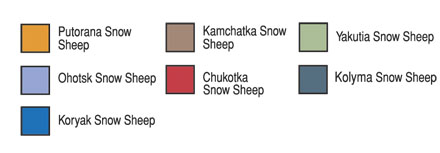 |
 |
Ovis nivicola nivicola
Carnero de las nieves de Kamchatka (Sp), Kamchatka Schneeschaf (G), Mouflon des neiges du Kamtchatka (F). Sometimes incorrectly called Kamchatka bighorn, but it is actually a thinhorn, the same as other snow sheep and also the Dall and Stone sheep of North America.
DESCRIPTION Color is grayish-brown or grizzled. The white rump patch is rather small and is divided by a dark stripe that continues down the tail. Muzzle is white, but the brown facial band, which so strongly characterizes the Verkhoyansk population to the west, is almost lost. Head and neck may show a varying degree of grayish-white. The horns protrude outward, around and down in almost 1-1/2 curls to perfect, unbroomed tips. The two longest-horned snow sheep of record are from Kamchatka, one with horns measuring 41.7 and 40.9 inches (105.9 and 103.9 cm), the other with horns of 41.7 and 39.5 inches (105.9 and 100.3 cm). These heads are superb, with the horns pinching close to the face, then sweeping outward, around and down in almost 1-1/2 curls to perfect, unbroomed tips.
DISTRIBUTION The Kamchatka Peninsula of Siberia, south of the low-lying isthmus that occurs at about latitude 60°N.
TAXONOMIC NOTES Consists of storki (western Kamchatka) and nivicola (eastern Kamchatka), with nivicola Eschscholtz, 1829 having priority.
|





